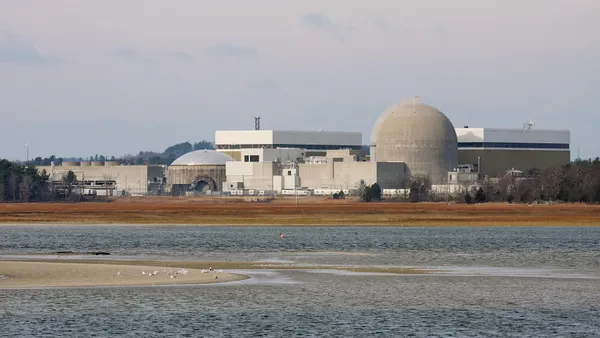As the deadline draws near for compliance with the Federal Energy Regulatory Commission's (FERC) landmark energy storage order, PJM Interconnection's proposed changes give a glimpse into how to remove barriers for wider wholesale market participation from the technology.
FERC's order applies to all Independent System Operators (ISO) and Regional Transmission Organizations (RTO) but to date, PJM's process for complying with Order 841 has been among the most transparent.
When it was released in February, Order 841 was hailed as a landmark ruling that could open the "floodgates" for energy storage.
The energy storage market could grow to 50,000 MW if battery costs continue to decline and state policies build on FERC's order, according to a report by the Brattle Group released in the wake of the order.
PJM has already opened its market to frequency regulation by changing its rules to create a new product, Reg D, for fast responding assets. There are now about 300 MW of batteries operating in PJM's frequency regulation market. There are also about 5,000 MW of pumped hydro storage in PJM, but energy storage is not now fully participating in PJM's energy, capacity or ancillary services markets. That is changing under Order 841.
The FERC order directs operators of RTOs and ISOs to draw up non-discriminatory market rules for energy storage participation in wholesale power markets.
As stipulated in Order 841, PJM's proposal would allow energy storage resources to set prices and participate in the RTO's real time energy markets and its capacity market, which contracts for resources that can serve as energy reserves three years into the future. The critical difference, however, comes not from complying with the FERC order but in how that compliance is structured. FERC laid out the basic parameters for leveling the playing field for energy storage, but left it up to the individual RTOs and ISOs how to apply those rules.
Under current rules, energy storage resources can participate in PJM's real time and day-ahead power markets, but only as self-scheduled resources. The rules do not allow them to be dispatched by setting prices. That would change under PJM's proposal.
Energy storage would be able to bid into PJM's real time or day ahead energy markets at prices that would determine whether or not they are dispatched. PJM's proposal would allow energy storage resources to bid in three different modes: charge, discharge and continuous.
"The reason we have three modes is in order to accommodate all types of resources,"

Laura Walter
Senior lead economist, PJM 841 compliance project
In discharge mode, a bid would appear the same as any other resource. In charge mode, a storage operator would place a negative bid for a set amount of capacity. In continuous mode, an operator would offer a combined bid of both negative and positive MW and would be dispatched to charge or discharge depending on market conditions.
"The reason we have three modes is in order to accommodate all types of resources," Laura Walter, PJM's senior lead economist on the 841 compliance project, told Utility Dive.
The three modes of operation also allow the operators of battery storage systems to manage their own state of charge, which is often a sticking point in any discussion on market rules for energy storage.
Grid operators want to ensure that a resource has sufficient charge to perform when called upon. But operators of energy storage resources say that mandating a set state of charge deprives them of the ability to optimally manage the revenue streams of their resources.
PJM's approach to the problem is to allow storage operators that control, but then to subject them to penalties for non-performance. It is the same approach PJM took when it designed its Capacity Performance product in response to the frigid temperatures of the Polar Vortex of 2014, which impaired the operation of some generation resources.
Another frequent issue that comes up in energy markets is the settlement time interval. PJM's proposal calls for hourly settlement in the day-ahead market, but makes five minute settlements available in the real time market.
Generally speaking, "a shorter settlement period is better because it can better capture market volatility," Judy Chang, a principal at the Brattle Group, told Utility Dive. "For storage, that could be a big deal."
Studies Brattle has done indicate that allowing storage to dispatch on a five minute, instead of an hourly, basis could result in a 30% increase in energy revenues.
The granularity of time
In addition to the granularity of the settlement times, another instance where time makes a difference in potential revenues for energy storage is in the capacity market.
Being able to participate in capacity markets, as well as ancillary markets, is often hailed as an important consideration for energy storage as it could allow operators access to more than a single stream of income.
When it comes to capacity market rules for energy storage, however, PJM is adhering to the status quo. The RTO's proposal calls for keeping the minimum duration for capacity resources the same, at 10 hours.
Few energy storage resources can meet that standard, particularly battery storage systems which usually have a maximum duration of about four hours.
PJM's proposal does follow FERC's 841 guidelines, however, because energy storage can still participate in the capacity market. The operator of a battery storage system, for instance, would just have to derate the asset to meet the minimum duration requirement.
Bids into wholesale market are not just based on price, but price and offered capacity. For simplicity's sake, for a 1 MW, 1 MWh storage system to meet the proposed capacity market criteria, it would have to offer 100 kW over 10 hours.
"It will be very interesting if you start to see storage participating in multiple markets."

Tim Grejtak
Energy storage analyst, Lux Research
That would allow an energy storage resource to participate in the capacity market but it would take a toll on the efficiency of the unit. The operator would have to pay the full cost of the battery and the inverters but would only receive revenues for a fraction of its potential output. "For a battery to derate by a factor of 10 or so, is a pretty high hurdle," energy storage analyst Tim Grejtak at Lux Research, told Utility Dive.
"The 10 hour duration requirement is a long standing requirement for participation in the PJM capacity market," PJM's Walter said. She also said the proposal is in keeping with FERC's guidance. "We are not changing our technical specification; we want to define products."
Walter also said that if the duration requirement were shortened, the capacity market would be able to accommodate a lower level of storage penetration.
From a revenue perspective, however, capacity market participation "is probably the biggest ticket item," Brattle's Chang said.
FERC's wider goal with Order 841 is to encourage the penetration of energy storage in wholesale market in order to drive down energy prices and the costs of energy storage.
"It will be very interesting if you start to see storage participating in multiple markets," Grejtak said. That could drive more revenues to the bottom line which could drive the cost of energy storage down further, leading to wider participation.
As that happens, could lower costs also squeeze margins for energy storage operators?
"That is going to be tricky," Grejtak said. "It will be very exciting over the next year or two to see the data that comes from this living experiment."





















